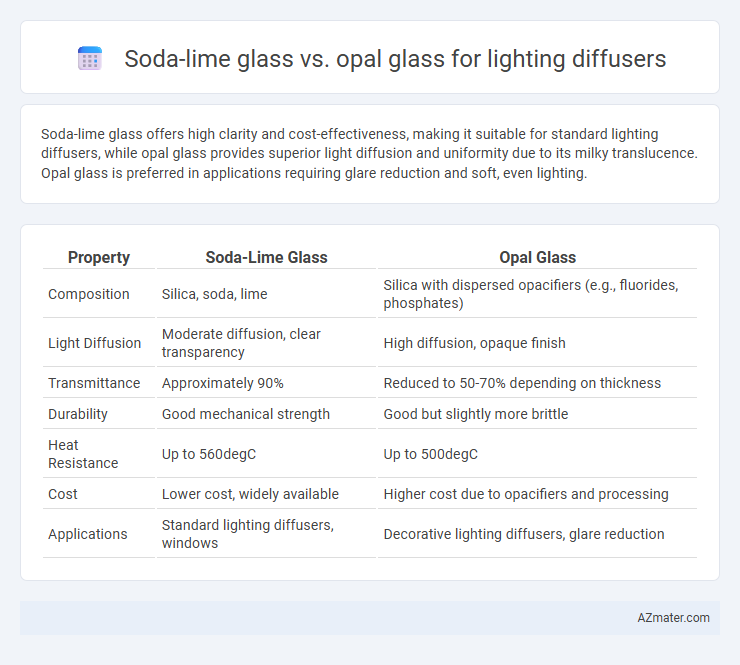Soda-lime glass offers high clarity and cost-effectiveness, making it suitable for standard lighting diffusers, while opal glass provides superior light diffusion and uniformity due to its milky translucence. Opal glass is preferred in applications requiring glare reduction and soft, even lighting.
Table of Comparison
| Property | Soda-Lime Glass | Opal Glass |
|---|---|---|
| Composition | Silica, soda, lime | Silica with dispersed opacifiers (e.g., fluorides, phosphates) |
| Light Diffusion | Moderate diffusion, clear transparency | High diffusion, opaque finish |
| Transmittance | Approximately 90% | Reduced to 50-70% depending on thickness |
| Durability | Good mechanical strength | Good but slightly more brittle |
| Heat Resistance | Up to 560degC | Up to 500degC |
| Cost | Lower cost, widely available | Higher cost due to opacifiers and processing |
| Applications | Standard lighting diffusers, windows | Decorative lighting diffusers, glare reduction |
Introduction to Lighting Diffusers
Lighting diffusers enhance light distribution by softening and spreading illumination to reduce glare and shadows. Soda-lime glass, commonly used for diffusers, offers high transparency, mechanical strength, and cost-effectiveness but provides less light scattering. Opal glass contains fine inclusions that scatter light more effectively, producing a smooth, even glow ideal for diffusers requiring uniform brightness in architectural and decorative lighting applications.
What is Soda-lime Glass?
Soda-lime glass is the most common type of glass used for lighting diffusers due to its affordability, durability, and excellent light transmission properties. It consists primarily of silica (about 70-75%), soda (sodium oxide), and lime (calcium oxide), which provide stability and resistance to chemical corrosion. Compared to opal glass, soda-lime glass offers higher clarity but less diffuse light output, making it suitable for applications requiring bright, unobstructed illumination.
What is Opal Glass?
Opal glass is a type of glass that contains tiny air bubbles or opacifying agents, creating a diffused, milky white appearance ideal for lighting diffusers. Unlike soda-lime glass, which is clear and commonly used for general applications, opal glass effectively scatters light to reduce glare and provide uniform illumination. The unique composition of opal glass enhances light diffusion while maintaining durability, making it a preferred choice for modern lighting fixtures and diffusers.
Light Transmission and Diffusion Qualities
Soda-lime glass offers high light transmission with clarity, making it ideal for applications requiring maximum brightness and minimal color distortion. Opal glass, characterized by its milky, opaque finish, provides superior diffusion qualities that evenly scatter light, reducing glare and creating a soft, uniform illumination. For lighting diffusers, opal glass is preferred when enhanced light diffusion and anti-glare properties are critical, while soda-lime glass suits settings demanding bright, clear light output.
Strength and Durability Comparison
Soda-lime glass exhibits moderate strength with good impact resistance, making it suitable for standard lighting diffusers but prone to scratches and breakage under heavy stress. Opal glass, composed of finely powdered glass with opacifying agents, offers enhanced durability and superior resistance to thermal shock and mechanical wear, ensuring longer lifespan in demanding lighting applications. The higher density and tougher composition of opal glass make it a preferred option when strength and longevity of lighting diffusers are critical factors.
Aesthetic Differences in Illumination
Soda-lime glass offers a clear, bright illumination with high transparency, making it ideal for lighting diffusers that require maximum light output and sharp detail visibility. Opal glass provides a soft, diffused glow by scattering light uniformly, reducing glare and creating a warm, ambient atmosphere preferred in decorative and residential lighting. The choice between soda-lime and opal glass impacts the aesthetic quality of illumination by balancing brightness with diffusion, influencing the mood and visual appeal of illuminated spaces.
Cost and Availability Factors
Soda-lime glass is widely favored for lighting diffusers due to its lower cost and high availability, making it a cost-effective choice for large-scale production. Opal glass, while providing superior diffusion and aesthetic appeal, generally incurs higher material and manufacturing expenses, limiting its use in budget-sensitive projects. The widespread supply chain of soda-lime glass ensures consistent availability, whereas opal glass availability can be more limited and subject to higher lead times.
Applications in Lighting Fixtures
Soda-lime glass is widely used in lighting fixtures for its cost-effectiveness and clarity, making it ideal for applications requiring high light transmission and durability. Opal glass offers superior diffusion properties, providing uniform light distribution and reducing glare, commonly applied in decorative and architectural lighting to create soft, ambient illumination. Both materials serve distinct roles: soda-lime glass suits functional lighting with clear visibility, while opal glass enhances aesthetic appeal and comfort in interior lighting design.
Environmental Impact and Sustainability
Soda-lime glass, commonly used in lighting diffusers, offers high recyclability and lower energy consumption during production compared to opal glass. Opal glass involves more complex manufacturing processes with additional raw materials, increasing its environmental footprint and carbon emissions. Choosing soda-lime glass improves sustainability by reducing waste and enhancing material reuse in the lighting industry.
Choosing the Right Glass for Your Lighting Diffuser
Soda-lime glass offers excellent clarity and affordability, making it suitable for lighting diffusers requiring high light transmission and cost efficiency. Opal glass provides superior diffusion with a smooth, frosted appearance that reduces glare and softens light, ideal for creating uniform illumination in residential or commercial settings. Choosing the right glass depends on the desired balance between light diffusion quality, aesthetic preference, and budget constraints for your lighting application.

Infographic: Soda-lime glass vs Opal glass for Lighting diffuser
 azmater.com
azmater.com